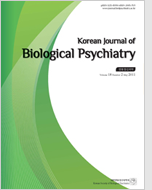
- Past Issues
- e-Submission
-

2021 Impact Factor 1.766
5-Year Impact Factor 1.674
Editorial Office
- +82-01-9989-7744
- kbiolpsychiatry@gmail.com
- https://www.biolpsychiatry.or.kr/

2021 Impact Factor 1.766
5-Year Impact Factor 1.674
Korean Journal of Biological Psychiatry 2006;13(1):19-25. Published online: Jan, 1, 2006
Background:Some reports have suggested that decreased nitric oxide
metabolites(NOx) and activity of nitric oxide synthase could be related to the pathophysiology of depression. We evaluated plasma levels of
NOx in pregnant women with and without postpartum depression at prenatal and postnatal period.
Methods:The plasma concentrations of NOx were measured in 104 pregnant women in the third trimester and at 6 weeks postpartum and in 64 normal controls. The severity of depression and anxiety was measured with the Edinburgh Postnatal Depression Scale(EPDS), Beck Depression Inventory(BDI), and Beck Anxiety Scale(BAI).
Results:Plasma NOx levels at 6 weeks postpartum were significantly lower in cases of postpartum major depression(EDPS scores≥13 points) than in cases without depression(EDPS scores≤9 points). Plasma
NOx levels had significantly negative correlation with EPDS scores at 6 weeks postpartum.
Conclusion:We demonstrate that decreased plasma NOx is associated with postpartum depression. Further studies are required to determine whether individual serum concentration of plasma
NOx alone could predict maternal depression.
Keywords Postpartum depression;EPDS;Nitric oxide;NO<sub>x</sub>.